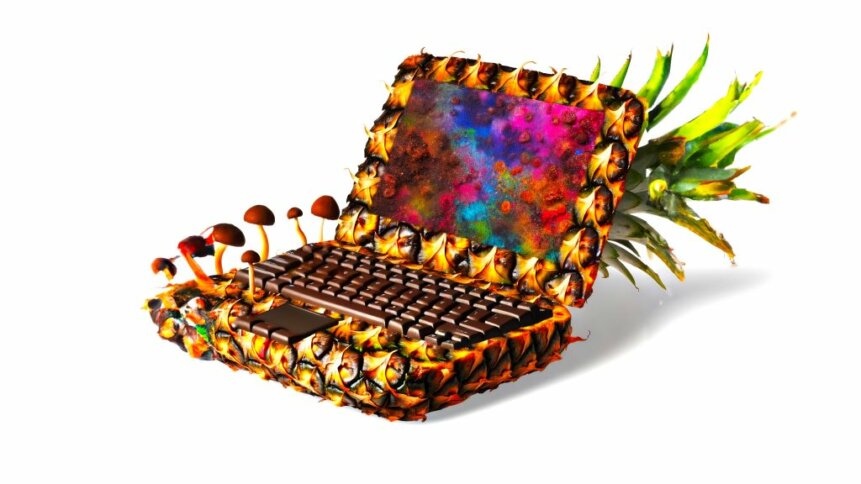Fungi, coffee, and pineapples – rethinking device materials

|
Getting your Trinity Audio player ready...
|
In the automotive sector, consumers have long traded in their old vehicles for a discount on a new model. And that approach is gaining traction in today’s growing circular electronics economy. Consumers are encouraged to extend the useful life of their mobiles, tablets, laptops, and other smart electronics by trading in old devices. Leaders in the field have even likened flagship smartphones produced by Apple and Samsung to vehicles made by automotive brands such as BMW, Audi, and Mercedes – given that products can have long lifetimes and serve many owners. But this is just scratching the surface of what can be done to reduce the carbon footprint. By rethinking device materials – considering novel feedstocks such as fungi, coffee, and pineapples – future products could be greener than ever before.
On TechHQ, we’ve highlighted the merits of using fungal machines as unconventional computers, and mushrooms could benefit the technology sector in multiple ways. Materials experts have been investigating whether the thread-like roots of fungi – known as mycelium – can serve as the basis for eco-friendly structures. Rethinking device materials could mean that products are simply composted at the end of their lifecycle, reducing the burden of electronic goods on the planet.
Repurposing waste as smart packaging
Researchers in Thailand (publishing their work in the journal Mycology – more details below) have shown that using a mixture of natural materials – in their case, fungi, coffee, and pineapple leaves – means that the properties of the eco-friendly composite products can be fine-tuned. What’s more, rethinking device materials is an opportunity to repurpose waste.
In their work, coffee grounds – collected from Starbucks coffee shops in Bangkok – are used as a filler and substrate for the mycelium spawn to grow into. The mixture can be placed into a mold to give the natural composite a desired shape. Once a sufficient amount of the mycelium network has formed, the mold and its contents can be transferred to an oven and cured at 80 degC to inhibit any further fungal growth.
Coffee is an extremely popular drink globally. However, only a tiny fraction of the hundreds of millions of kilograms of coffee beans consumed annually makes its way into the cup. Well over 99% of the roasted material ends up as spent coffee grounds – so there’s no shortage of feedstock for industrial users keen to explore novel applications.
Interestingly, the Ford Motor Company and fast-food giant McDonalds teamed up a few years back to convert coffee bean skin into car parts. “Every year, millions of pounds of coffee chaff – the dried skin of the bean – naturally comes off during the roasting process,” wrote Ford in its announcement. “Together, Ford and McDonald’s can provide an innovative new home to a significant portion of that material.”
Car parts that were produced included headlamp housings for Ford’s luxury vehicle brand, Lincoln. The parts were around 20% lighter than their petroleum-based predecessors and required less energy to produce, which point to further advantages alongside waste repurposing.
Actually starch composites are made of thermoplastic starch resin. By varying the amount of plasticizer, reinforcing fiber, etc., properties of the final product can be varied. The bags made from our raw materials can be 100% Biodegradable and Compostable. #GreenMaterials pic.twitter.com/dJJAmyje9q
— Huawei New Materials (@huaweinm6) August 8, 2023
Returning to the Thai team’s work, the group also added pineapple fibers (sourced from the leaves of the plant) to the bio-composite mix. Adding pineapple fibers affects the flexural strength of the composite, which means that materials can be designed to bend more or less, to suit the application.
And – just like with any regular device packaging – self-powered Bluetooth sensors can be added to support the circular economy further, as we’ve mentioned previously on TechHQ.
The development of compostable device materials is a hugely promising area, and we may well see products made from fungi, coffee, and pineapple feedstocks in all shapes and sizes in the future.
“Moving forward, we aim to delve into techniques such as 3D printing to mold mycelium composites, a topic that stands as a priority in our ongoing studies,” write the researchers in their paper – ‘Fabrication of mycelium (oyster mushroom)-based composites derived from spent coffee grounds with pineapple fibre reinforcement (Open Access). “Integrating 3D printing technology with mycelium composites provides a pioneering method for creating items with unmatched accuracy and adaptability.”
Starting with a few components to highlight what bio-composites are capable of, it’s possible that the production of future electronic goods will be less reliant on plastics sourced from fossil fuels. The United Nations has signaled its determination to end plastic pollution – beginning with a ban on single-use plastics – and this will encourage materials suppliers and customers to consider alternatives.
Naturally, pricing will be critical, but given the abundance of raw materials such as coffee grounds – which are classed as waste – rethinking device materials could turn out to be a profitable endeavor.








